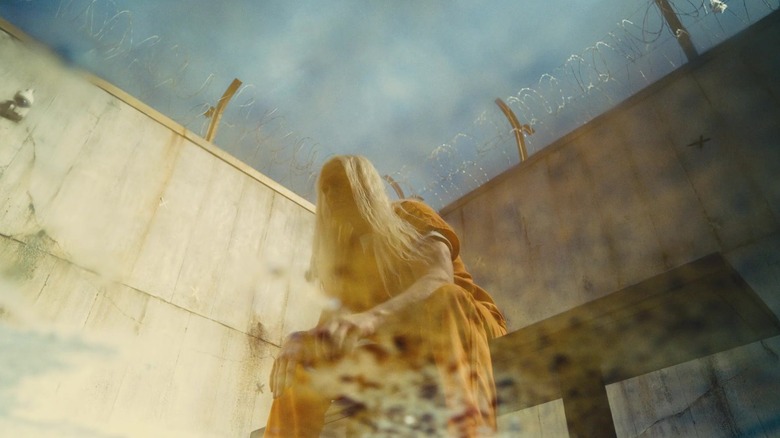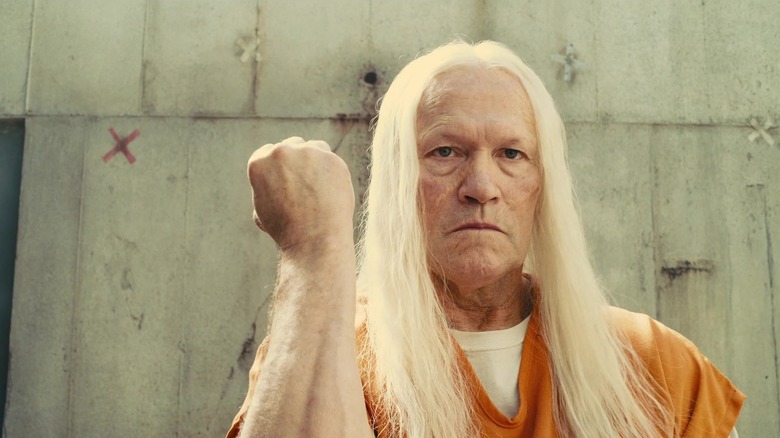James Gunn's Last Second Inspiration Led To Suicide Squad's Unique Opening Shot
James Gunn's 2021 superhero movie "The Suicide Squad" had a lot to prove. This was the sequel to (and quasi-reboot of) of 2016's disastrous "Suicide Squad," a film so bad it probably sped up the collapse of the DC Extended Universe by at least a year. Gunn needed to prove that he'd made a different sort of movie, complete with some actual energy and personality behind it.
And from its very first shot, most viewers knew they were in good hands. "The Suicide Squad" opens with a shot of a puddle, introducing Savant (Michael Rooker) through its reflection. The camera tilts upward, and before it fully settles on Savant, we see him from two different angles in the same frame. There's a lot to love about this opening shot (for one thing, it efficiently foreshadows Savant's water-based death 10 minutes later), but mostly, it just looks cool. Reflections, much like cigarette smoking, can give off the impression of a classy, high-budget film despite not being expensive at all to use.
In an episode of the official podcast for Gunn's HBO Max series "Peacemaker," the filmmaker explained that this shot wasn't planned ahead of time. It was originally supposed to be a standard shot of Savant in his cell, with a small puddle shown on the floor as part of the set design. Gunn then explained the sudden lightbulb moment he had:
"I saw that he was reflecting in that water, and I'm like 'Well, wouldn't it be cool if we got...' And I knew that [cinematographer] Henry Braham had this rolly contraption in the camera vehicle. [...] I'm like, 'Can we go get the rolly contraption, add a little more water so we can see him a little more clearly?' And then we did that."
The Suicide Squad's opening shot shows Gunn's growth as a director
The most notable part of the opening shot for Gunn is the realization that he never would've taken the chance on it earlier in his career. Although he'd directed multiple films by this point, "The Suicide Squad" was the first one where he felt fully confident in his abilities.
"If that had happened on 'Guardians 2,' I would have gone, 'Oh, that would have been great if I had thought of that while I was storyboarding.' But I would fascistically stick to the storyboards," Gunn explained. Sticking to the storyboards helps to keep a movie production on schedule and within budget, but sometimes it's better to follow your sudden on-set inspirations.
Indeed, a lot of Gunn's fans have noted a slight stylistic shift in his films between "Guardians of the Galaxy Vol. 2," and "The Suicide Squad" (which came out four years apart). Gunn has attributed this to him prioritizing less of what he thinks mainstream audiences want and more of what he himself wants out of his movies. "Start[ing] with 'Suicide Squad,' I really started shooting the movie exactly as I wanted to," he explained.
It's hard to argue too much with the results. "Guardians of the Galaxy Vol. 2" might be his best movie overall, but the direction on "The Suicide Squad," in particular, has an inspired, easygoing feel to it. The visuals feel uniquely unrestrained and creative, making it a joy to watch even when something wildly violent is happening on screen. It's just a shame "The Suicide Squad" underperformed at the box office, because I'd say it was the best movie the entire DCEU had to offer.

